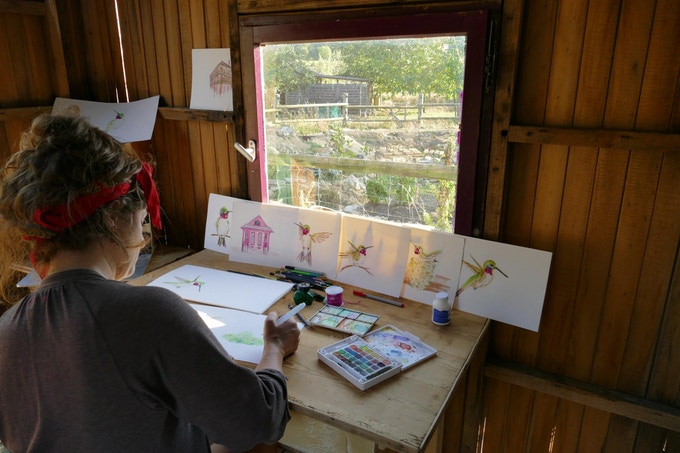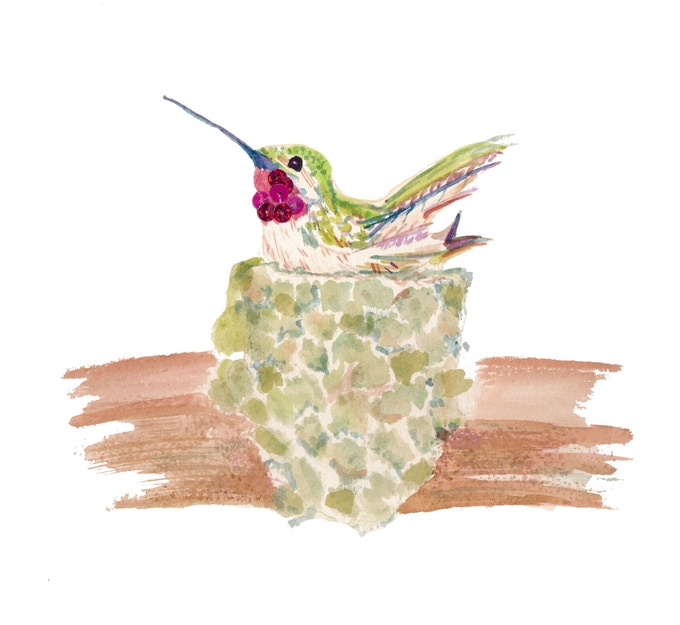Editor’s Note: Olivia Motley has moved into a new endeavor with her children’s book, “Do You Know What it Means to Miss New Orleans,” which follows the life of Huey, an Audubon Park hummingbird that is about to embark on his very first migration south for the winter. She has a kickstarter for the book, which is where you can find out more about her project as well as support her project.

Olivia Motley working on her newest project, a children’s book entitled “Do you Know What it Means to Miss New Orleans.” (Photo: Olivia Motley)
Who: Olivia Motley
What: Photographer, documentarian, painter, model maker, set designer, and children’s book author
Where: Germany (although part of her heart is still in New Orleans)
Just so you know: The first time I interviewed Olivia it was on her back balcony, which was covered in plants and overlooking courtyard rooftops. She moved far away from New Orleans 3 years ago to teach English to kids in Spain, but New Orleans remains, “…a continual source of inspiration and comfort to me no matter where I am.”
Q: Tell me about a recurring dream or a dream that you can’t forget.
A: I have recurring snake nightmares. All of the time. Sometimes they’re snakes that don’t exist or snakes that aren’t even scary. One of them was made out of string and coconuts once, and supposedly it was super poisonous and trying to kill me. It was called the ‘Peanut Snake’.
I’ve had dreams where I’m on my bike and snakes are jumping up trying to bite my legs. So, I obviously have a phobia — and I’ve pondered this for a while. I think it goes back to two different parts of my childhood.
When I was three years old, I was best friends with my dog. We lived on a lake, and my dog and I would always go for walks. One time a snake came up and my dog just attacked it. She was a golden retriever, so she was never aggressive and hadn’t ever killed anything before. Seeing her murder that snake made me realize that they must be super evil.
Then I was at summer camp — when I was seven years old, and one of the counselors had caught and killed a water moccasin, which are super venomous — I remember being really scared and then the counselor said to me, ‘Yeah, and it’s pregnant.’ Then she cut the snake open, and this next part might have to do more with me watching Indiana Jones, because when she cut it open all I saw were baby snakes slithering out of the dead snake’s body.
I’m pretty sure that snakes lay eggs, so I don’t even think that memory is true. But that’s what I remember. I can’t change that image, so it’s in my memory forever.
Q: What image do you never tire of seeing?
A: Clouds. I go crazy for clouds. I actually wrecked a car once because I was staring at this beautiful cloud. And since there aren’t any mountains in New Orleans — although, I also love seeing mountains, that might be another one — the clouds here are unbelievable.
I’ve also found that people celebrating anything in New Orleans is so incredibly captivating. Anytime I go out with my camera — right now I’m using a Holga which doesn’t have a mirror, you can’t change the ISO, and is rather experimental — I get so lucky with my shots.
It’s interesting playing around with film, especially because I’m so interested in taking photos of people. There’s this dilemma of I want to ask people for permission, but once I do that, they pose for the picture. I mean, not necessarily like this [puts hands under chin, tilts head and sweetly smiles]. It’s more that they become aware that they’re being photographed, and that changes the nature of the picture. But something about the film, or maybe it’s that camera, still reads very authentic even if the person does pose a bit.
I don’t know how to explain that phenomenon, but capturing those moments feels so timeless. I just wish I knew who the people were because I’d love to share those photos with them. My hope is that one day they’ll find their picture. That’s the only reason I embraced using hashtags [laughs].
Q: What is a strange question that you ask your friends?
A: If I were immortal — you know, a vampire — would you want me to bite you? And here’s the worst part, when they say ‘No,’ I take it really personally.

Huey, the protagonist in Olivia Motley’s children’s book “Do you Know What it Means to Miss New Orleans.” (Photo and watercolors by: Olivia Motley)
Q: How would you describe truth?
A: I don’t even know if truth can exist in what it’s supposed to be. The only way to say that something is true is to be personally connected with it. I know when I’m hungry, but I can’t say when you’re hungry. Yet, there’s this back and forth of us thinking one thing about ourselves, doing another, and then we’re changing all the time
With the documentary I did, Flotsam, it’s so different. I went to school for set design, which is all about creating worlds that don’t exist. That’s one of the things I love about film — you can do things that you can’t in real life. I mean, I don’t get excited for sets like ‘Interior dentist office in modern world’ or anything because I don’t even want to go there in real life. But the idea of building a huge cave with birds hanging upside down — and there’s a monster — is so appealing. It’s something different from what you normally see.
And yet, I make documentaries, which typically don’t have any set design. I’m so blown away by these moments that can happen in documentaries that are not staged. That are so real and just unbelievably beautiful. When we were shooting Flotsam, our short documentary about the street sweepers for Mardi Gras, there was this point where the parade had ended, there was trash everywhere, and a woman in a blue wig was walking around perusing the trash. She’s walking and looking, and then she bends down, picks up this little blue whale stuffed animal, and walks off. And she’s all by herself.
Sitting there with a camera — just being still and documenting — is like a time capsule. With Flotsam we didn’t want to interrupt the sweeper’s work at all. We wanted to show how amazingly efficient they are and show their perspective, and the images speak for themselves.
I didn’t know what to expect from the workers going into the project, and we found — almost across the board — that the workers love Mardi Gras. They’re super proud of keeping this city that they love clean. It’s amazing.
There’s this magical scene we got where the sweepers are waiting on Tchoupitoulas Street before Cleopatra had started. Out of nowhere, this straggler float comes by and stops right in front of them. Then these twenty-five or so sweepers start dancing and putting their hands up for throws, and the people on the float just go nuts and start throwing all this stuff to them. In moments like that—moments that we all know so well—we all become six-year-olds who want that piece of plastic that someone is throwing.
Because that’s something uniquely beautiful about Mardi Gras in New Orleans. One of the men I interviewed put it perfectly. He said, ‘Everywhere else you go that there’s parades, there’s the parade and the people that watch. Here, we interact. We’re part of it. Because we’re asking and they’re giving. There’s no wall between us’.
Olivia Motley has moved into a new endeavor with her children’s book, “Do You Know What it Means to Miss New Orleans,” which follows the life of Huey, an Audubon Park hummingbird that is about to embark on his very first migration south for the winter. She has a kickstarter for the book, which is where you can find out more about her project as well as support her project.
 NOLAbeings Multimedia artist Claire Bangser created NOLAbeings as a portrait-based story project that marries...
NOLAbeings Multimedia artist Claire Bangser created NOLAbeings as a portrait-based story project that marries...  Voodoo in New Orleans: Reviving history: New Orleans fortune telling This article takes a deep dive into the history of Voodoo in New Orleans, its hybridization with Catholicism, and its present-day place in the city's culture. The author visits fortune-tellers in the French Quarter, using their guidance as a tool for introspection rather than a deterministic predictor of the future. Through her experiences in New Orleans, the author feels a mystical connection to both the past and the future.
Voodoo in New Orleans: Reviving history: New Orleans fortune telling This article takes a deep dive into the history of Voodoo in New Orleans, its hybridization with Catholicism, and its present-day place in the city's culture. The author visits fortune-tellers in the French Quarter, using their guidance as a tool for introspection rather than a deterministic predictor of the future. Through her experiences in New Orleans, the author feels a mystical connection to both the past and the future. 